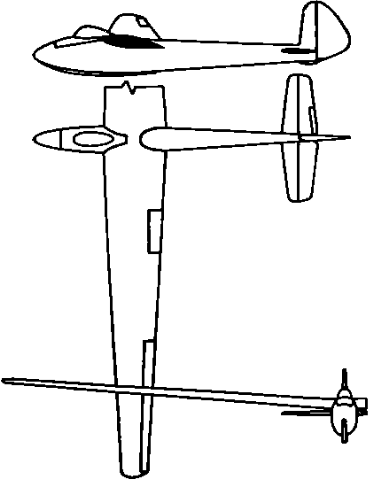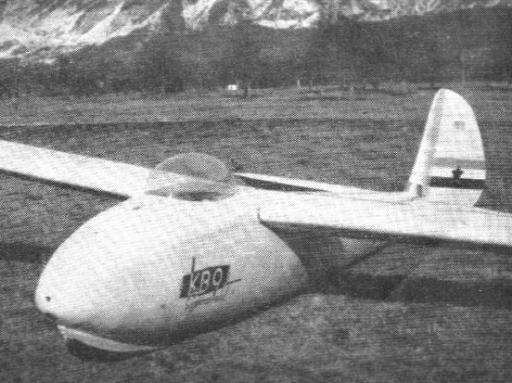KB-9 Experimental
The era of sailplanes with classic wing sections was definitely over but the data for laminar sections were still scarce. Nevertheless, it was decided to design a new plane KB-8 with a combination of laminar (Mustang) wing section at the root and a classic one at the tip. A lot of research went into this new design but when the plane was to be built the funds ran out and the plans were archived. After a year the situation improved but it was still not possible to build a completely new plane. It was necessary to compromise and so it was decided to use the fuselage of the KB-2 Udarnik that was collecting dust in a corner of the workshop. The complete tail unit was also to be used but just before the plane was completed the rudder was replaced by a spare one from German "Weihe" sailplane. The new plane was christened KB-9 and as it was basically designed to
test a laminar wing built out of wood the attribute "Experimental" was
also used. The wing was built using new technology. Airbrakes were moved
to the trailing edge so that the wing had as few gaps as possible. The
calculated glide ratio was 1:32 with the wingspan of 16 m. |

The plane was very well built and the wing surface was really smooth. It was taken to Lesce airfield for the first flight. The test pilot was chief designer Marjan Slanovec and the flight went very well. But true quality of the design showed up at landing. It was intentionally made with the airbrakes retracted and the plane just kept going and going. The actual measured glide ratio was 1:32.5 and that by itself proved that the wing 'laminarity' was indeed obtained. The speed polar indicated that the plane would penetrate well. Further testing showed some bad points too. Airbrakes were uneffective, probably because they were situated at the trailing edge. Minimum speed was high but the biggest problem was the blown bubble canopy which at low speeds was placed at such an angle that provoked the airflow to break off behind it. This in turn caused unstable airflow conditions at the wing root. KB-9 is an all wood shoulder-set wing plane. Wings are built
utilising a new technology and covered with plywood. Ailerons are small
but highly effective, the gap between the wing and the aileron is
covered with fabric. The airbrakes are basically a section of the wing that
rotates 90o when airbrakes are applied. |

As mentioned before the fuselage is that of the KB-2 with modified wing attachement and the dorsal fin removed. The cockpit has a lot of room with the canopy being relatively small. Tail surfaces are plywood covered, very sensitive trim tab is on the right side. |
| Data | Prototype |
|---|---|
| Wing span | 16.00 m (52 ft 6 in) |
| Length | 7.60 m (24 ft 11 1/4 in) |
| Wing area | 16 m2 (172 sq ft) |
| Aspect ratio | 16 |
| Dihedral | 4o |
| Wing section | NACA 643-C18 |
| Best glide ratio | 32.5 at 83 km/h (35.5 at 45 kt) |
| Min sinking speed | 0.7 m/sec at 70 km/h (2.3 ft/sec at 38 kt) |